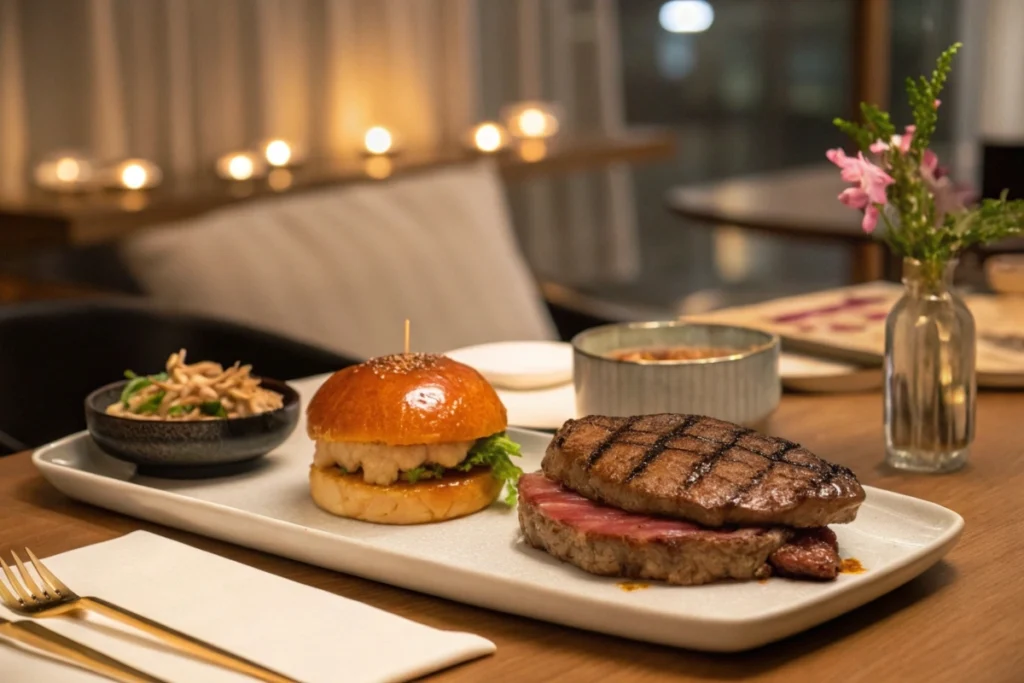Introduction
What if you could make tiny, sweet japanese food kits burgers in your own kitchen? That’s the delightful premise behind brands like Popin’ Cookin’, which offer candy-based DIY sets that transform powders into miniature hamburger “buns,” “patty,” and “sauce.” While these confections obviously don’t taste like real beef, they offer a fun, hands-on experience for all ages. The joy lies in blending creativity with an iconic comfort food—burgers. By simply adding water, mixing, and molding, you’ll end up with mini candies that look like mini hamburgers.
Over the past few years, these novelty kits have captured global attention. Hobbyists, families, and curious foodies alike share videos of themselves whipping up adorable burger sets, complete with mini fries and “cola.” If you’ve never tried a candy hamburger kit before, prepare to be intrigued. These sets deliver a playful combination of culinary crafting and sugary delight.
In this guide, we’ll explore everything you need to know about japanese food kits burgers, from the cultural phenomenon of Popin’ Cookin’ to where you can buy these kits at a reasonable price. Interested in contrasting these sweets with real Japanese dishes? Try more easy Japanese recipes to expand your palate alongside your mini-burger candy adventures.
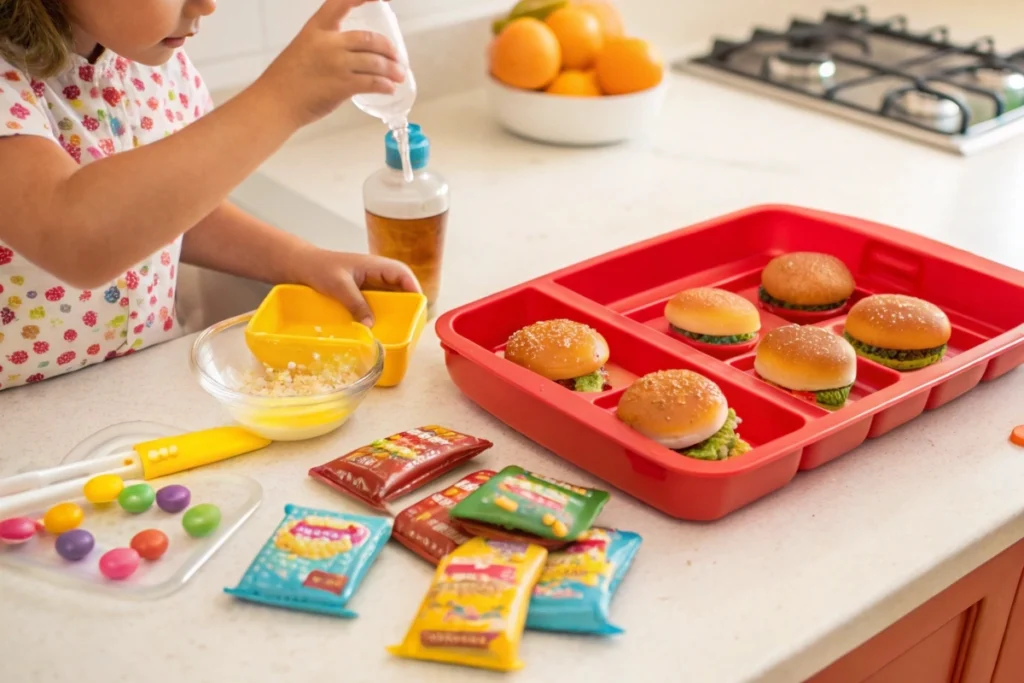
1. The Popin’ Cookin’ Phenomenon
Japanese food culture is renowned for its creativity, and that flair extends to candy-making. One of the most popular brands fueling the japanese food kits burgers trend is Kracie’s Popin’ Cookin’. The brand offers a broad range of mini meal kits—everything from sushi to pizza to doughnuts—but the hamburger popin cookin set stands out as a fan favorite.
Origins of Popin’ Cookin’
Launched over a decade ago, Popin’ Cookin’ quickly gained traction among Japanese children for its colorful packaging and interactive approach to candy-making. Instead of passively unwrapping candy, kids could measure water, mix powders, shape the result in molds, and then enjoy their sweet creations. Over time, word spread beyond Japan’s borders, and the kits started appearing in Asian grocery stores worldwide.
Why Mini Burgers?
Burgers symbolize Americana, but they also align well with Japan’s love for bite-sized, kawaii (cute) items. The candy hamburger version typically includes powdered mixes that form buns, meat, cheese slices, and sauce. For extra authenticity, some kits even have you craft mini fries and a tiny cup of fizzy soda. The novelty factor alone makes it share-worthy on social media, which has further propelled popularity.
Appeal to All Ages
While primarily marketed to children, Popin’ Cookin’ kits captivate adults too. They represent an artistic, stress-relieving pastime—akin to painting or crafting. When the final product actually looks like a miniature burger meal, the sense of accomplishment (and amusement) is palpable.
If you’re curious about other playful or artistic Japanese food kits, explore other Japanese kit inspirations. Some sets aren’t strictly candy but still offer a tactile, creative experience reminiscent of making real dishes—albeit on a tiny scale.
Conclusion of the Craze
The mini food phenomenon shows no sign of slowing. With the prevalence of videos on TikTok, Instagram, and YouTube showcasing these unique kits, the hype continues to grow. For many, the next step after trying a candy burger kit is exploring actual Japanese recipes or building a mini-food collection spanning various cuisines.
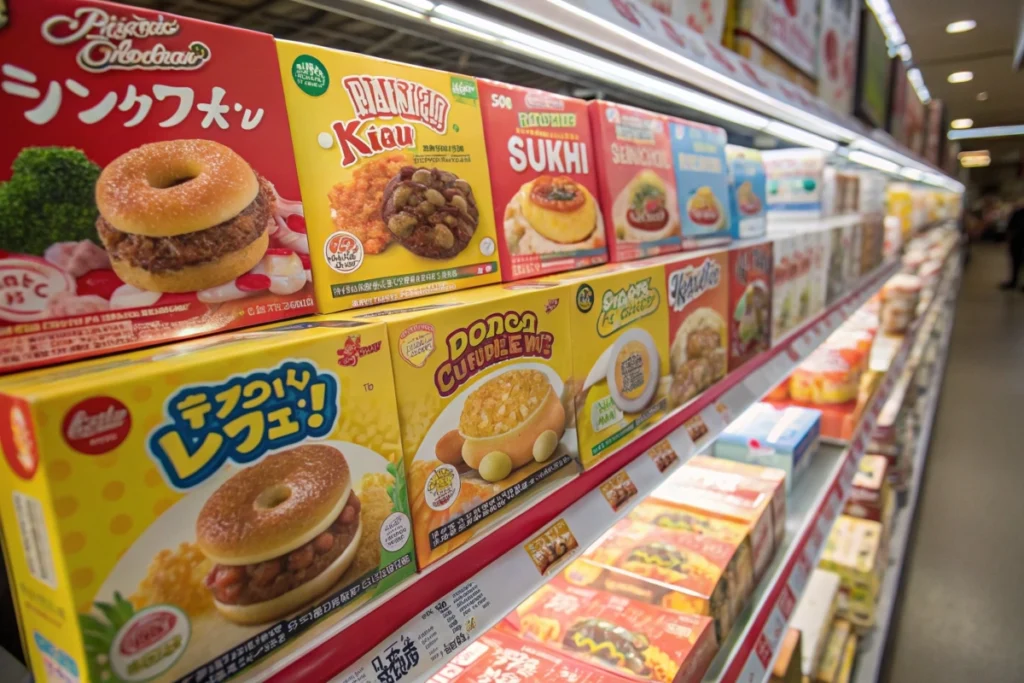
2. Inside Japanese Food Kits Burgers
So, how exactly do japanese food kits burgers work? While specific details may vary by brand, most kits follow a similar setup. The box usually contains several small powder packets, each designated for a different component of your mini meal—buns, patty, cheese, sauce, and often fries. You’ll also find a plastic tray with compartments, molds for shaping your “foods,” and instructions. Some sets require a quick trip to the microwave for final touches, but most rely on water mixing for transformation.
Typical Kit Contents
- Powder Packets: Labeled for buns, patty, cheese, fries, and sometimes ketchup or soda
- Plastic Trays/Molds: Essential for shaping the burger buns and fries into recognizable forms
- Spoon or Dropper: Makes measuring water simpler
- Instruction Sheet: Typically in Japanese, but often with illustrations. Some kits include English inserts, or you can look up “popin cookin hamburger English instructions” online.
Step-by-Step: Making a Candy Hamburger
- Bun Dough: Mix water with the bun powder in one section of the tray. Knead it until it feels dough-like. Press it into the round mold.
- Patty Powder: Combine water with the patty powder. Pour it into a rectangular mold. This mixture may mimic the color and texture of a burger patty once firm.
- Cheese Slice: Another powder turns into a pliable sheet. Flatten it on the tray to form a mini slice.
- Fries: Some kits include fries that start as a thick dough, then you slice them into mini fry sticks.
- Microwave or Wait: Depending on the kit, you might microwave the patty and fries to firm them up. Others solidify at room temperature.
- Sauce & Assembly: A separate packet forms ketchup or a sweet sauce. Drizzle it on top before stacking your patty, cheese, and bun.
- Final Touch: If the kit includes a soda mix, add water to create a fizzy liquid that tastes sweet and slightly carbonated.
Sweet vs. Savory
While many hamburger candy sets are sweet, some lesser-known kits attempt a mild savory flavor. However, these are rare and generally overshadowed by the popular, sugary versions. Even the “bun” often tastes like a sweet biscuit rather than plain bread.
If you find yourself craving a real dessert afterward, discover unique Japanese sweets recipes. Contrasting these candy burgers with an authentic sweet treat can be an eye-opening experience, reminding you of the rich variety in Japanese confectionery.
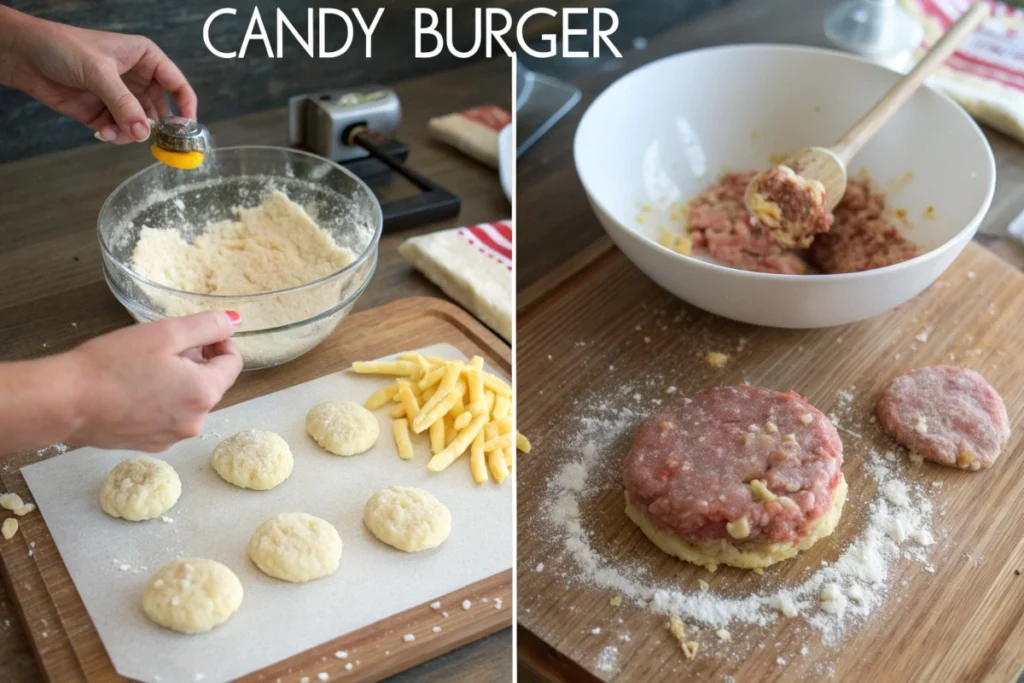
3. Where to Buy and What to Expect
Once you decide to try japanese food kits burgers, the question is where to find them. Let’s delve into the most common purchasing options, plus some tips for ensuring you get authentic products and a fair price.
Online Retailers
Major E-Commerce Platforms: Websites like Amazon or eBay often carry hamburger popin cookin sets. You can compare different sellers for the best deal. Reading reviews helps confirm the kit’s authenticity.
Specialty Candy Stores: Some online shops focus on Japanese snacks and novelty items, featuring a variety of Popin’ Cookin’ themes.
Local Asian Grocery Stores
If your city has a robust Asian community, there may be shops that stock these candy kits. They often appear in the snacks or kids’ aisle. Ask the staff if you can’t locate them. Terms like japanese food kits burgers for sale or referencing “Popin’ Cookin’ hamburger” may ring a bell.
Price Range
A single kit typically costs between $3 and $8, depending on the region and store. Limited-edition or newly released kits might command slightly higher prices. Buying them in a bundle can be economical if you’re planning a party or group activity.
Shipping and Storage Considerations
If you buy online, shipping costs can add up. Some retailers offer free shipping if you meet a minimum purchase threshold. Candy kits don’t usually expire quickly, but check the “best by” date, especially if you’re buying multiple packs. Store them in a cool, dry place to preserve flavors.
Authenticity & Language
Beware of knock-off or expired kits. Legitimate Popin’ Cookin’ products have brand logos, high-quality packaging, and consistent color schemes. Many boxes are primarily in Japanese with bright, playful graphics. If you need help with instructions, searching “popin cookin hamburger English instructions” online yields step-by-step guides, often accompanied by videos.
For those who want an even broader selection of Japanese sweets, consider looking into Japanese dessert recipes or other candy kits. The variety is immense, from gummy sushi to chocolate fondue sets. This diversity underscores just how creative Japanese snack culture can be.
4. Fun Alternatives: Sushi Candy Kit & More
While japanese food kits burgers are undeniably fun, they represent just one slice of the mini food world. Brands like Kracie have developed numerous candy hamburger and sushi candy kit variations. Let’s explore some playful alternatives to expand your candy-making adventures.
Sushi Candy Kit
Often labeled as Popin’ Cookin’ Sushi, this kit allows you to create tiny, sweet sushi rolls that look shockingly like the real thing. Orange gummy bits mimic fish roe, while white gummy dough stands in for sticky rice. The visual appeal is high, making these ideal for photos or social media posts. It’s a fascinating way to introduce kids to sushi textures—albeit a sugary version.
Pizza Mini Kits
If you’re already a fan of mini burger sets, you might also appreciate pizza kits. Like the hamburger sets, pizza candy typically forms dough, sauce, and cheese from various powders. Though it’s sweet, the final look can be quite realistic. Add some mini pepperoni candy bits for authenticity!
Other Mini-Food Combos
- Donut Kits: Chocolate, strawberry, or vanilla mini donuts you can decorate with sprinkles.
- Bento Sets: Include multiple compartments for shaped candy items that resemble classic Japanese lunch box dishes.
- Takoyaki or Ramen Kits: Less common but definitely part of the broader line of playful candy experiences.
Where Culture Meets Candy
Japan’s emphasis on kawaii (cuteness) and attention to detail merges effortlessly with these mini sets. If you’re intrigued by how food and culture intertwine in Japan, the Japan National Tourism Organization provides deeper insights. Meanwhile, these candy kits serve as a delightful entry point, letting you “cook” an entire meal—just in miniature, sweet form.
From Candy to Real Cooking
After you’ve gotten a taste (literally) of candy-based Japanese foods, you might be curious about authentic Japanese recipes. Hamburger candy might push you to learn about the actual Japanese hamburger steak, known as Hambāgu, or other fusion dishes. These real-world meals reflect the fun and flavor of Japanese cuisine without the sugary twist.
5. Tips and Serving Ideas for Your Candy Burgers
Crafting japanese food kits burgers can be more than a solo activity—it can become a memorable communal experience. Here are some suggestions to help you elevate your candy burger-making sessions:
1. Prep Your Space
Before opening your kit, clear a flat surface. Ensure you have a small cup of water, paper towels, and scissors on hand. This organization makes the process smoother and more enjoyable. If you’ll be microwaving certain elements, keep a microwave-safe plate nearby.
2. Add a Real Snack Pairing
While your candy burgers will be sweet, you can offer real savory snacks alongside them. A bowl of edamame, for instance, can balance out the sugar. Or, if you want to highlight Japanese flavors, try miso soup or Japanese chicken fried rice as a hearty counterpart.
3. Host a Mini Burger Party
Consider inviting friends over for a “mini-burger cook-off.” Supply each person with a kit, then let everyone compete to see who assembles the most realistic-looking hamburger candy. Provide small plates for presentation, and have guests vote on factors like creativity, neatness, and taste. This concept works well for birthday parties, family gatherings, or any event where you want a unique activity.
4. Use Additional Decorations
If you have icing pens or small candy sprinkles, feel free to add some flair. Create your own “hamburger candy” garnish—tiny sesame seeds made from sprinkles can add extra visual charm to the “bun.” The sky’s the limit when it comes to sweet artistry!
5. Document the Process
These kits are popular on social media for a reason: they’re incredibly photogenic. Snap pictures or record short videos of each step—unboxing, mixing, molding, assembling. You can compile them into a fun reel or TikTok video. If you have kids, capturing their reactions can be priceless.
6. Keep It Educational
A subtle bonus is that these kits can teach measurement, following instructions, and basic principles of cooking—albeit in a candy context. Parents or teachers can briefly discuss the science of absorbing water, forming dough, or how microwaves heat substances to firm them up.
7. Explore More Options
Once you’re comfortable with burger kits, don’t hesitate to branch out. Sushi, pizza, donuts—each kit provides a fresh set of challenges and flavors. Over time, you might compile a mini “cookbook” of your candy conquests.
By combining creativity, social interaction, and a dash of culinary curiosity, japanese food kits burgers can become a highlight of any gathering or a fun weekend project that leaves you with sweet, bite-sized memories.
History and Context of Japanese Food Kits Burgers
The story behind japanese food kits burgers is intrinsically tied to Japan’s broader history of candy innovation. For decades, Japanese confectioners have been pushing the boundaries of what constitutes “candy,” blending artistic design with interactive preparation. Traditional wagashi sweets taught the industry to value visuals and seasonal themes. As modern manufacturing techniques advanced, brands like Kracie took the next step by creating DIY sets that let users become candy chefs for a day.
Early Candy Culture in Japan
Traditional sweets often played a role in tea ceremonies or religious festivals. These treats emphasized delicate flavors and intricate shapes. By the mid-20th century, Western confectionery began influencing Japan’s candy scene. Colorful packaging and cartoon mascots became more common, reflecting the growing demand for child-friendly snacks.
Emergence of DIY Kits
In the 1980s and 1990s, Japanese candy companies introduced small sets that combined powdered mixes, water, and molds. Kids could produce simple shapes—like small animal gummies—learning to measure and stir. By the early 2000s, the concept expanded to replicate entire meals: sushi, burgers, ramen, pizza. This shift corresponded with a cultural fascination with miniatures, from dollhouse dioramas to detailed plastic model kits.
Popin’ Cookin’ and the Hamburger Revolution
Kracie’s Popin’ Cookin’ line launched around this time, quickly gaining popularity. The brand capitalized on Japan’s dual love for novelty and cuteness. Hamburger candy sets soon followed, elevating these kits beyond just shapes into near-realistic mini meals. Small finishing touches—like forming “fries” and simulating “cola” fizz—added a theatrical element, making the kits shareable on social media.
International Recognition
YouTube played a pivotal role in exposing the world to these candy kits. Viral videos showed enthralled YouTubers mixing powders to form tiny burgers, spurring global curiosity. Online retailers began stocking japanese food kits burgers, shipping them internationally. Bloggers and vloggers started testing them as a new form of culinary entertainment.
Ongoing Evolution
Today, the candy kit market continues to grow, often releasing limited-edition flavors or region-specific variants. Meanwhile, enthusiasts remain dedicated to discovering new kits and showcasing them online. This synergy between consumer engagement and product innovation ensures that japanese food kits burgers remain a fascinating, evolving aspect of Japan’s confectionery legacy.
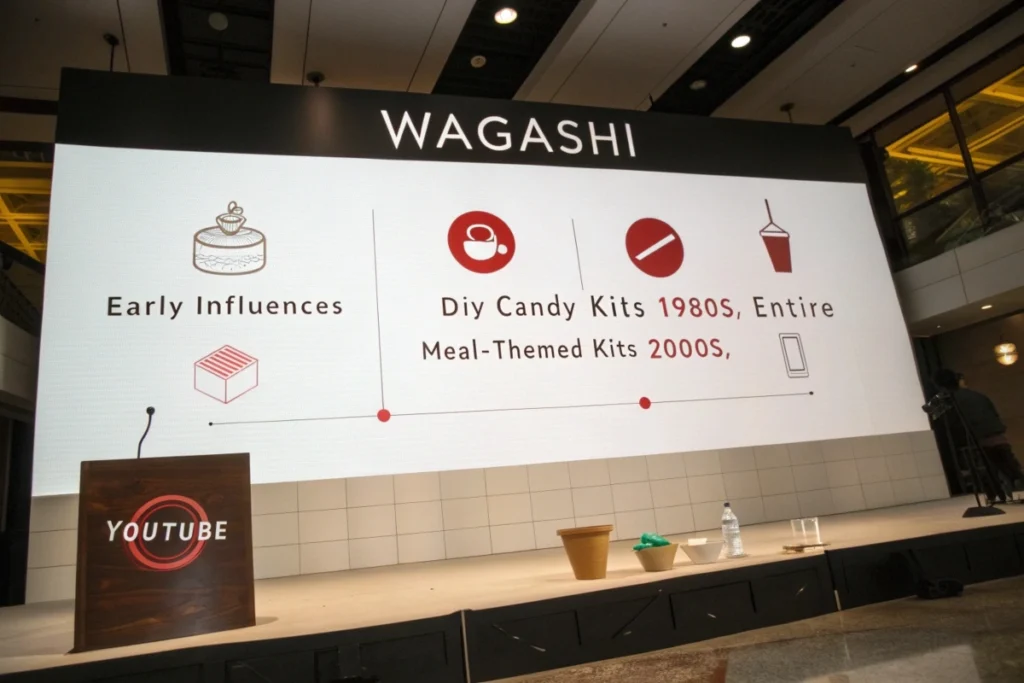
Practical Examples and Use Cases
Japanese food kits burgers can brighten up almost any social setting or personal pastime. Here are three scenarios where they truly shine:
Scenario 1: Kids’ Party Novelty
Imagine hosting a birthday party for a group of energetic 8-year-olds. Instead of standard cake and ice cream, you introduce a candy hamburger-making station. Each child receives a mini kit. Parents help them measure water and guide them through shaping buns and patties. After a bit of messy fun, they line up their finished mini burger candies on plates. Everyone laughs and compares designs, turning the celebration into a memorable event.
Scenario 2: Classroom Project
A middle school teacher plans a brief lesson on Japanese culture and creative food. With permission from the school, the teacher brings in a set of burger candy kits. Students follow instructions, forming buns, patty, and fries. The teacher ties it into a discussion about how food can reflect cultural values—like presentation and aesthetics. It’s a playful yet educational approach that helps students remember the lesson far better than a textbook might.
Scenario 3: Date Night Twist
Surprise your partner by setting up a quirky at-home “cooking” date. After dinner, you break out the hamburger candy kits. Between laughter and friendly competition over whose burger looks best, you bond over this silly yet satisfying project. For extra fun, you might also combine the candy with a tasting of real Japanese desserts, adding a sweet conclusion to the evening.
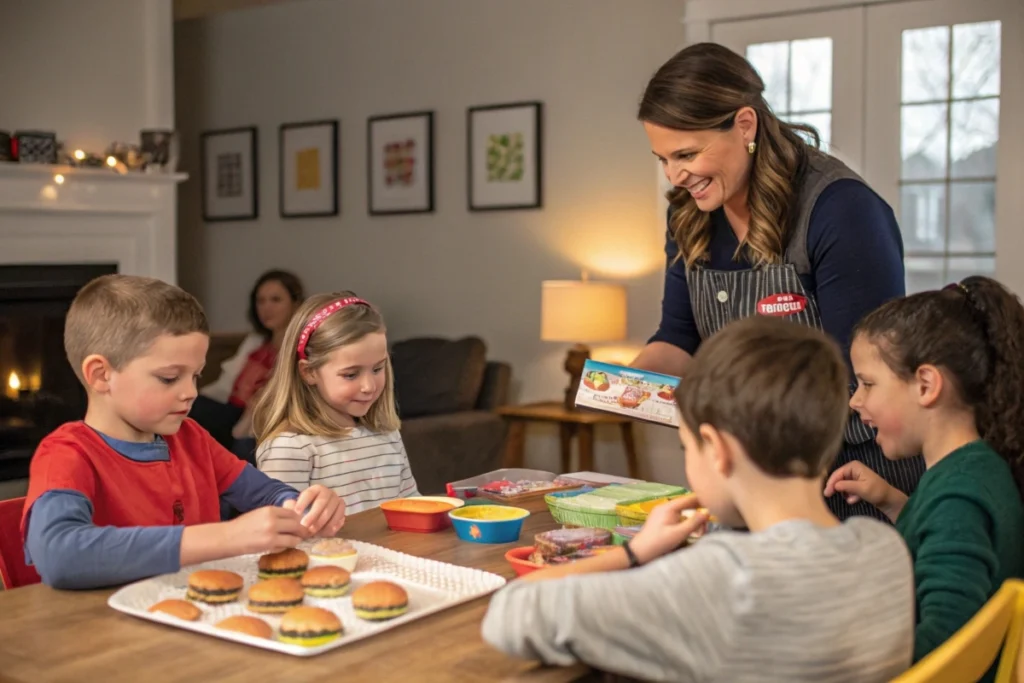
FAQs
Below are some frequently asked questions about japanese food kits burgers and related mini-meal candy kits:
- Are japanese food kits burgers sweet or savory?
Most kits are sweet, although certain varieties attempt a mild savory flavor. The “bun” often tastes like a sweet biscuit, while the “patty” is more like a chewy, chocolate or caramel-like candy. Check the package to see if it’s labeled as sweet or savory. - Where can I find japanese food kits burgers recipe or instructions in English?
Many kits come with Japanese-language packaging, but websites like YouTube or candy fan blogs provide detailed English instructions. Searching “popin cookin hamburger English instructions” will yield step-by-step tutorials, often with visuals. - How long do these candy hamburgers last once made?
It’s best to eat them soon after preparation. The texture and flavor may deteriorate if left exposed for too long. Generally, they’re enjoyed immediately or within a few hours, especially if you want the best consistency. - Are there bigger kits that produce more realistic hamburgers?
Most standard kits are designed to be snack-sized. While some might include microwavable components for a slightly more authentic appearance, they remain novelty candy items rather than actual burgers. - Do these kits require a microwave?
Some do, some don’t. The majority rely on mixing and molding at room temperature. Read the package instructions or online guides to see if microwaving is needed for your particular kit. - Can I get japanese food kits burgers where to buy near me?
If you have a local Asian market, you might find them in the candy or kids’ section. Otherwise, online retailers offer a wide selection, often shipping globally. Check popular e-commerce sites or specialty Japanese snack shops. - How do they compare to other Popin’ Cookin’ items, like the Popin’ Cookin’ sushi kit?
Each kit has its own charm. Candy sushi kits are typically more colorful and highlight gummy textures, while burger kits focus on layering buns, patty, and cheese. Both are equally fun, just different in theme and execution.
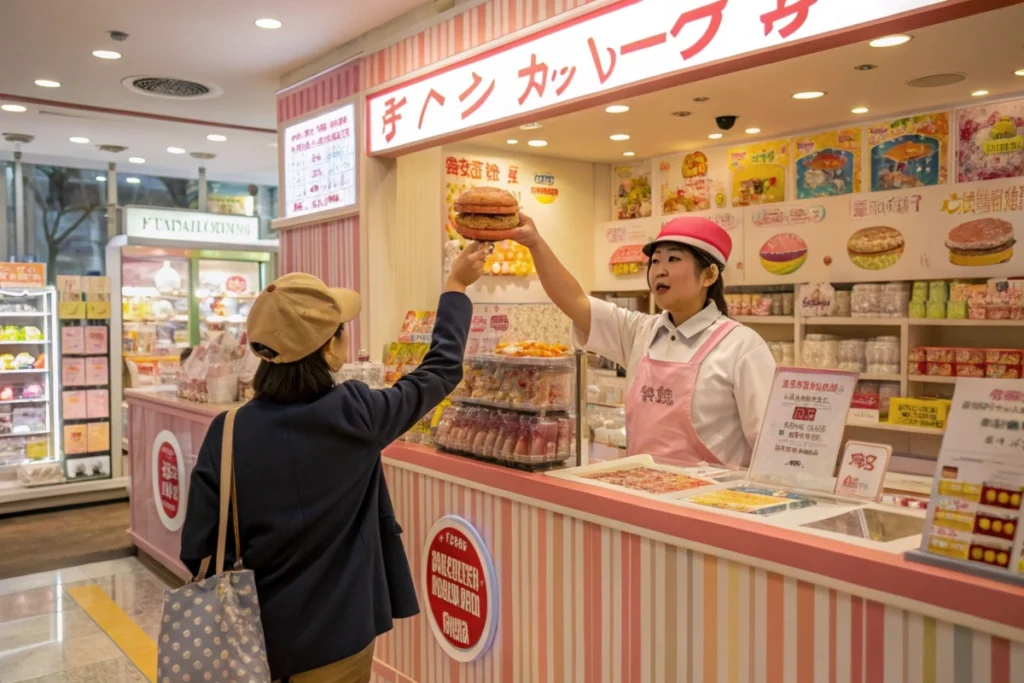
Conclusion
Whether you’re a candy connoisseur, a curious foodie, or simply looking for a unique group activity, japanese food kits burgers check all the boxes. They’re delightful, creative, and surprisingly detailed—transforming plain powders into miniature burger meals that almost look real. As you navigate the world of Popin’ Cookin’ and similar brands, you’ll discover how Japan’s innovative snack culture can turn everyday concepts, like hamburgers, into playful confections.
Though these kits primarily exist for amusement, they do offer an engaging window into Japan’s approach to novelty, cuteness, and attention to detail. Whether you plan a party, a classroom lesson, or a casual evening of tiny “cooking,” the joy lies in both the process and the final reveal—candy fries, sauce, and all.
Ready to dive deeper into Japanese cuisine? You might complement your mini-burger adventure by trying a real dish like Japanese steak recipe for dinner. Then, wrap up the night by crafting your sweet little hamburger set for dessert. In a world that often feels hectic, indulging in these mini marvels can bring a moment of playful relaxation.
